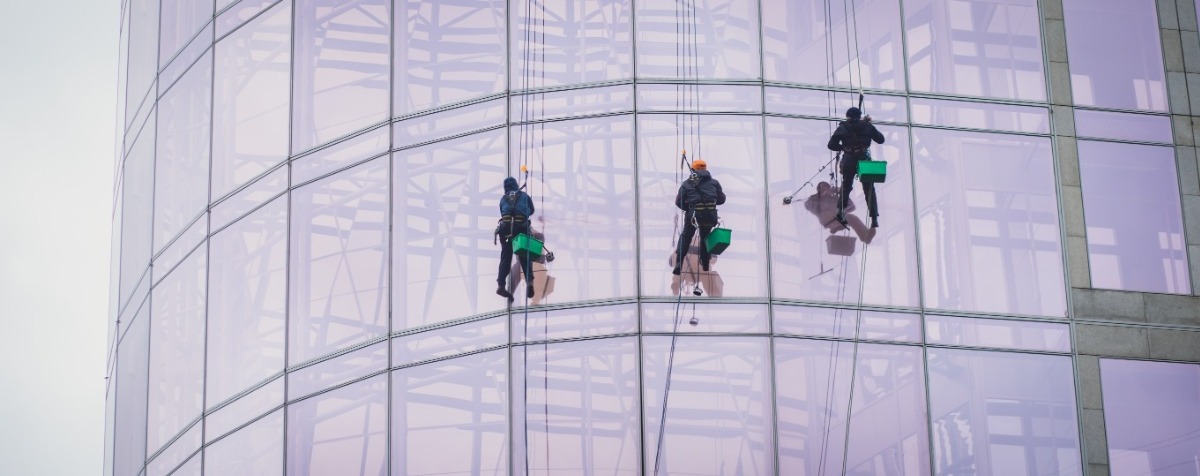Creating a High-Rise Window Cleaning Safety Plan
Creating a high-rise window cleaning safety plan
In the high-rise window cleaning industry, safety is paramount. Given the risks of working at great heights, it is vital to establish a detailed safety plan. This article outlines the steps to create a comprehensive high-rise window cleaning safety plan, covering its significance, legal requirements, essential components, and ongoing evaluation. By adhering to these guidelines, you can ensure the protection of your employees and the smooth running of your window-cleaning operations.

Understanding the Need for a Safety Plan
Before discussing the specifics, it’s essential to understand why a safety plan is crucial for high-rise window cleaning. A safety plan serves as a blueprint to identify potential hazards, define protocols, and safeguard workers. Implementing such a plan not only protects employees but also helps preserve your business’s reputation and financial stability. Additionally, it fosters a safety-first culture that boosts employee morale and productivity.
The inherent dangers of high-rise window cleaning, such as falls from heights, equipment malfunctions, and exposure to harmful chemicals, are serious. Weather conditions, like high winds or heavy rain, can further amplify these risks. A thorough risk assessment helps identify hazards and develop preventive measures, such as maintaining equipment, providing worker training, and ensuring the availability of safety gear like helmets and harnesses.
Legal and Regulatory Compliance
Adhering to legal and regulatory standards is critical for any window-cleaning business. Familiarize yourself with occupational safety regulations, building codes, and industry standards to align your safety plan accordingly. Compliance not only protects your workers but shields your business from potential liabilities.
Safety regulations differ by location and project type, so it’s important to stay informed about current standards. Participating in safety seminars or consulting industry experts can help ensure your safety plan remains relevant and up to date.
Key Elements of a High-Rise Window Cleaning Safety Plan
A robust safety plan involves more than compliance; it’s about cultivating a company-wide culture of safety. Let’s explore its key components:
Equipment Safety Inspections
Routine checks of window-cleaning equipment are essential to prevent accidents due to equipment failure. Create a detailed checklist for regular inspections and maintenance of tools like harnesses, ropes, and scaffolding. Investing in high-quality equipment from reputable sources is equally important, as cutting costs in this area can lead to catastrophic consequences.
Employee Safety Training
Proper training is vital in high-risk industries. Ensure all employees receive thorough instruction on safe work practices, equipment handling, emergency response, and hazard communication. Refresh training regularly to reinforce safety awareness. Encourage workers to voice safety concerns and participate in safety initiatives to create a sense of responsibility and ownership.
Emergency Response Procedures
A clear emergency response plan is crucial. Outline detailed procedures for evacuations, first aid, emergency contacts, and communication methods. Conduct regular drills to familiarize employees with these steps and ensure all equipment and communication systems function properly in emergencies.
Putting the Safety Plan into Action
Creating a safety plan is only the beginning; it must be actively implemented and regularly updated. Building a safety culture within your organization is key. This involves making safety a priority for both management and frontline workers. Recognize and reward safe behaviors, and continuously provide training to make safety a core part of your operations.
Conducting Safety Audits
Regular safety audits are necessary to evaluate the effectiveness of your plan. Inspections of equipment, employee interviews, and workplace condition reviews should be conducted routinely. Address any gaps promptly to enhance the safety of your operation. Including employees in the auditing process fosters a collaborative approach to safety management.
Communication
Effective communication is vital to ensuring all employees understand and follow the safety measures in place. Use safety meetings, emails, and signage to regularly update workers. Encourage feedback and open dialogue to continuously improve safety protocols.
Regular Updates to the Safety Plan
Safety plans should evolve as technology, industry standards, and risks change. Review your plan periodically to ensure it stays relevant. Engage with industry experts and regulatory agencies to remain informed of best practices. Involve employees in the review process to ensure the plan reflects real workplace needs and practices.
Evaluating the Plan’s Effectiveness
Ongoing evaluation of your safety plan is essential. Safety culture plays a significant role in adherence to protocols and overall accident reduction. Track key performance indicators (KPIs) such as the number of incidents, near misses, and employee compliance with safety measures. Leading indicators, like hazard identification and training participation, can help predict and prevent future incidents.
Employee Feedback
Employees are on the front line of your safety program. Regularly seek their feedback on the safety plan’s effectiveness and areas for improvement. Fostering open communication helps build a culture of continuous improvement, where employees feel empowered to take an active role in maintaining a safe work environment.
Continuous Improvement
Safety is an ongoing process. Strive for continuous improvement by updating training programs, adopting new technologies, and learning from past incidents. By creating a culture of continuous safety innovation, you promote long-term success in accident prevention and safety excellence.
Conclusion
Developing a high-rise window cleaning safety plan is vital to ensuring employee well-being and operational success. By understanding the importance of a safety plan, complying with regulations, implementing key components, and regularly evaluating effectiveness, you can create a safer work environment and minimize the risks associated with high-rise window cleaning.
J. Racenstein provides top-quality cleaning supplies and equipment for residential and commercial buildings. We pride ourselves on exceptional customer service and offer thousands of products to meet the cleaning industry's needs. Learn more about our products on our website.

